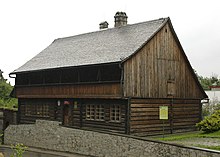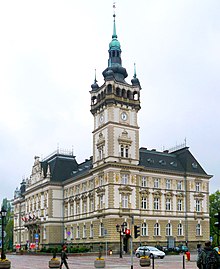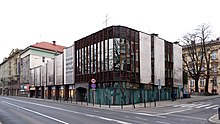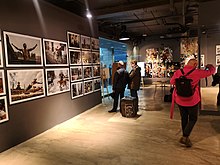User:Gaj777/sandbox
Economy and industry[edit]
At the end of 2021, 27,799 enterprises were registered in the National Official Register of Entities of the National Economy. 26,724 (96.13%) of them were in the private sector, and 597 (2.14%) in the public sector. Enterprises employing up to 9 employees dominated, with 26,619. Only three enterprises had more than a thousand employees.
The unemployment rate was only 2.2% at the end of 2021 and was significantly lower than the national and provincial average (among the cities of the Silesian Voivodeship, it was lower only in Katowice and Tychy). The average gross monthly salary in Bielsko-Biała was PLN 5,789.65, which corresponded to 96.5% of the average gross monthly salary in Poland. Among the economically active residents, 4,700 people traveled to other cities to work, and 24,302 people came to work from outside the municipality, meaning that the balance of arrivals and departures to work was 19,602. 42.9% of people worked in industry and construction, 21.3% in the service sector, 2.3% in the financial sector, and 0.9% in agriculture.
Historically, Bielsko-Biała was an important industrial center, especially of the textile industry, which, however, completely lost its importance as a result of the economic transformation after 1989. Among the few factories today that continue these traditions are the Befaszczot brush factory, the Befado shoe factory, the Zipper zipper factory and the Rytex wool fabric manufacturer.

Currently, the largest industrial area is located in the northern part of the city between Komorowice, Stare Bielsko and Dolne Przedmieście. This is the former Fabryka Samochodów Małolitrażowych, which was taken over by Fiat Auto Poland during the transformation and since 2021 has been part of Stellantis Poland. While actual car production now takes place in Tychy, the plant in Bielsko-Biała produces engines. Since 2000, the area has been one of the sub-areas of the Katowice Special Economic Zone. In subsequent years, further areas in Wapienica, Komorowice and Lipnik were included. In 2021, a total of twenty enterprises employing more than 4.6 thousand workers operated on the 82-hectare area of the special economic zone.
Other important factories based in Bielsko-Biala include Bielmar, which produces margarines, oils and animal feed, as well as the Silesian Vodka Factory POLMOS Bielsko-Biała, where Extra Żytnia vodka is produced.


Bielsko-Biala is among the cities with the highest saturation of retail space in Poland. According to a 2019 report by Colliers International, it was 1151 m² per 1,000 residents. In total, the city had 197,000 m² of retail space[164]. As much as one-third of this figure (64,100 m²) fell on the largest shopping and entertainment center, which is Galeria Sfera, located in the very center on Mostowa Street. It consists of two buildings - Sfera I and Sfera II - erected on the site of former industrial plants and completed in 2001 and 2009, respectively[165]. There are a number of other shopping facilities in the immediate vicinity, led by the "Klimczok" Cooperative Department Store owned by PSS Społem, which was built in 1988 and at the time was one of the largest in Poland[166][167].
Other large shopping and entertainment centers include Gemini Park on Bora-Komorowskiego Street opened in 2009 and expanded in 2014 (with a Bi1 hypermarket)[168] and Sarni Stok on the street of the same name existing since 2001 (with Carrefour and Media Markt supermarkets)[169]. Retail Park Karpacka[170] opened in 2014. The city also has Auchan, Kaufland, Makro, Castorama and Leroy Merlin hypermarkets, a number of supermarkets and smaller retail outlets. Of the once dense network of PSS Społem self-service stores, ten more existed in 2022 in addition to "Klimczok"[171].
The traditional shopping promenade is 11 Listopada Street. However, the number of stores and service outlets located through it has declined markedly in recent years, which is often attributed to the negative influence of large shopping centers[172][173][174][175]. City markets are located on Lompa Street and Broniewskiego Street, and there is also a market with an unregulated status in the Komorowice district[176].
The most important trade fairs held in Bielsko-Biala include the ENERGETAB Bielsko International Energy Fair organized by ZIAD Bielsko-Biala[177], as well as those whose organization is the responsibility of the ASTRA Promotion and Exhibition Office: the "Twój Dom" International Construction Fair, the "Instal-System" Fair of Heating Techniques and Energy Saving, and the EKOStyl International Fair[178]. The main venue for the fairs is the multi-purpose hall on Karbowa Street.
Sights[edit]

The Old Town of Bielsko is located on the Town Hill. It is characterized by an oval urban layout with a regular street grid running out from the corners of the rectangular Market Square (Rynek), typical of towns founded in the 13th century under the Magdeburg Law. The external appearance of the buildings dates mainly from the first half of the 19th century, when the town was restored after the fires of 1808 and 1836. Among the most picturesque corners are Podcienie Street, where 18th-century arcades are still preserved, and Schodowa Street, which is a step street. Along Orkana, Waryńskiego and Zamkowa Streets, fragments of the outer belt of town walls completed in the 16th century have been preserved.

Within the Old Town are two iconic historic buildings:
- Bielsko Castle, also known as the Castle of the Sułkowski Princes (Zamek książąt Sułkowskich), after the family that inhabited it from 1752 to 1945. The history of the castle dates back to the medieval frontier stronghold of the Dukes of Teschen, but its current appearance is the result of an eclectic reconstruction carried out in 1855-1864. It now houses the Historical Museum of Bielsko-Biala.
- Cathedral of St. Nicholas, a Roman Catholic parish church located on the site since the Middle Ages, to its present form rebuilt in 1909-1912 according to a design by Leopold Bauer. In 1992, the church became the cathedral of the newly created diocese of Bielsko and Żywiec.

To the north of the Old Town lies Bielski Syjon, a Lutheran quarter founded after Emperor Joseph II issued the 1782 Edict of Tolerance. There are important monuments associated with the Lutheran community here: the Church of the Saviour (1782-1790, then extended several times in the 19th century, including between 1881 and 1882 by Heinrich Ferstel), the only Luther monument in present-day Poland, unveiled in 1900, a complex of school buildings from the 19th century, and the Old Lutheran Cemetery.

To the west of the Old Town, along Cieszyńska and Sobieskiego Streets, extends the Upper Suburb (Górne Przedmieście). It is a former clothmakers' quarter with characteristic small-town buildings. Particularly notable among them is the wooden Weaver's House with a museum dedicated to the life and work of the clothiers in the pre-industrial era. Somewhat tucked away in Zdrojowa Street stands one of the first still preserved villas of Bielsko's rich factory owners - the Neo-Renaissance Villa Bartelmuss from 1872.


The Lower Suburb (Dolne Przedmieście), which extends to the north, is dominated by turn-of-the-century buildings. This is where the greatest concentration of Revivalist and Art Nouveau buildings to which Bielsko-Biała owes the term "Little Vienna" is to be found: the own house of the architect Carl Korn (1883), Villa Sixt (1883), Jędrzej Śniadecki School of Electrical, Electronic and Mechanical Engineering (originally "the High Schools Building", 1883), the former Municipal Savings Bank (Komunalna Kasa Oszczędności, 1889, with an extension of 1901 by Max Fabiani and another extension of 1908–1910), Main Train Station (1890), Theatre (1890), Hotel President (1893), Main Post Office (1898), the former district office (1903, now one of the seats of the Regional Court), Villa Schneider (1904), Bielsko Industrial School (Bielska Szkoła Przemysłowa, 1912). Architecturally valuable are the complexes of the bourgeois townhouses along 3 Maja, 11 Listopada, Barlickiego or Mickiewicza Streets. Bolesław Chrobry Square, commonly known as Pigal, between the Bielsko Castle and the former Municipal Savings Bank, is the de facto central square of the city today. A lesser role is played by Franciszek Smolka Square - the historic Lower Market.

The axis of the historic centre of Biała is 11 Listopada Street, laid out in 1780s. Numerous townhouses representing the so-called Josephine style (named after Emperor Joseph II) with Baroque and Neoclassical features have been preserved along it. The street, which today serves as the main promenade, passes through two of Biała's historic markets: Wojska Polskiego Square (Old Market Square, delineated in 1723) and Wolności Square (New Market Square, delineated in 1780s). The two main churches in Biała also date from the late 18th century: the Lutheran Church of Martin Luther (1782–1788) and the Catholic Church of the Divine Providence (1769, expanded in the 19th century). The Lutheran church is located next to the Old Market Square, while the Catholic church is on what used to be outskirts of the town, near the border with the village of Lipnik.


Biała's Town Hall, built between 1895 and 1897 in Neo-Renaissance style according to a design by Emanuel Rost Junior, today serves as the City Hall for the combined city. Other important architectural monuments from the turn of the 20th century in Biała are: the former Polish elementary school at Legionów Street (1898), Frog House (Kamienica Pod Żabami, 1903, a prominent example of Art Nouveau), Pedagogical Library (1903, originally the villa of Emanuel Rost Junior), the former hotel Under the Eagle (Hotel Pod Orłem, 1904) and the Economic High School (Zespół Szkół Ekonomicznych, 1910, originally the Polish Teachers' Seminary).

The architecture of the interwar period also plays an important role in the cityscape. The largest concentration of early Modernist housing is in the area of Bohaterów Warszawy, Wilsona and Grota-Roweckiego Streets, which has been built up since 1934 (before that, the castle gardens stretched here). The public buildings of the 1920s and 1930s include: Nicolaus Copernicus High School (1925-1927), a complex of buildings at the intersection of Sixta and Krasińskiego Streets (1922-1930), a fire station on Grunwaldzka Street (1928), and the new headquarters of the Municipal Savings Bank on the other side of Bolesław Chrobry Square (1938).
Historic industrial buildings are concentrated near the Biała River: in the Lower Suburb around Podwale and Grażyńskiego Streets, in the Żywiec Suburb (Żywieckie Przedmieście, southern part of Bielsko) and in Biała along Komorowicka Street. The Old Factory Museum in the former Büttner's textile factory ("Bewelana" during the socialist period), Jacob Gross's vodka and liqueur factory (later "Polmos") converted into lofts or Gustav Josephy's machine factory complex ("Befama") are some notable examples. In the area of Michałowicza Street, in the years 1892-1911, a workers' housing estate with familoks was built.
Significant examples of post-war architecture include: Grunwaldzkie housing estate (1951–1957), Bus Station (1972), City Library (1973), Church of the Sacred Heart of Jesus (1984), "Klimczok" Cooperative Department Store (1988) and Art Exhibition Bureau (1989, now Galeria Bielska BWA).
Culture[edit]
Cultural centres[edit]
The most important public institutions organising cultural life in the city are: Maria Koterbska Bielsko-Biała Cultural Centre (Bielskie Centrum Kultury im. Marii Koterbskiej, BCK), Regional Cultural Centre (Regionalny Ośrodek Kultury, ROK), Municipal House of Culture (Miejski Dom Kultury, MDK) made up of thirteen facilities including district culture centers including eight distric cultural centres, Military Cultural Centre "Soldier's House" (Wojskowy Ośrodek Kultury "Dom Żołnierza") and Cooperative Cultural Centre BEST (Spółdzielczy Dom Kultury BEST).
Theatres and cinemas[edit]

Polish Theatre (Teatr Polski) is a drama theater that was established after World War II as a successor to the German Stadttheater Bielitz, founded in 1890, and took over its historic building at 1 Maja Street. Banialuka Puppet Theatre (Teatr Lalek Banialuka) was founded in 1947 on the initiative of Jerzy Zitzman and Zenobiusz Zwolski. It is one of the leading institutions of its kind in Poland. In addition, numerous performances are staged at BCK cultural centre, and non-professional theater activities are conducted by the Bielsko-Biała Artistic Association Teatr Grodzki, founded in 1999.
Bielsko-Biała is known as the city where Studio Filmów Rysunkowych (SFR)—one of five animation studios established in post-war Poland—is headquartered. It has existed since 1947, and has produced such cartoons as Reksio, Bolek and Lolek, Margo the Mouse and a number of others. Among the most recent works is the series Kuba i Śruba, filmed between 2011 and 2016. In 2022, construction began on the site of the studio's headquarters at Cieszyńska Street of the Interactive Fairy Tale and Animation Center (Interaktywne Centrum Bajki i Animacji), which is to serve as a museum and thematic entertainment and educational center based on SFR's heritage. In connection with the construction, the Studio cinema, which is—after the closure of the Apollo and Rialto cinemas in 2002—the only art cinema in the city, has been suspended. Apart from it, Bielsko-Biala has two multiplexes: Helios in the Galeria Sfera shopping mall and Cinema City in the Gemini Park shopping mall.
Art galleries[edit]

The largest art gallery is Galeria Bielska BWA. It is a municipally owned institution founded in 1994 based on the transformation of the former Art Exhibition Bureau (Biuro Wystaw Artystycznych). It is located in the former Artists' Pavilion at 3 Maja Street, and since 2020 it has also had a second location in the historic Villa Sixt. There is a club café Aquarium at the main BWA site which hosts numerous cultural and social events.
Among private establishments, the Wzgórze Gallery, founded in 1987 by Franciszek Kukioła, and the Contemporary Art Gallery (Galeria Sztuki Współczesnej), the Ars Nova sculpture and ceramics studio, which has existed since 1991, and the Photography Gallery B&B, established in 1992 by Inez and Andrzej Baturo, have the longest and most vibrant tradition.
Museums[edit]

The Historical Museum of Bielsko-Biała (Muzeum Historyczne w Bielsku-Białej) has its seat in the Bielsko Castle, where the permanent exhibition is divided into nine parts: "History of Bielsko-Biała and its surroundings" (historical and archaeological exhibition), "Biedermeier" or bourgeois salon of the second half of the 19th century, "Music salon", "Hall of ancient art", "Shooting gallery" (collection of weapons), "Gallery of European and Polish painting of the 19th and 20th century", "Gallery of portrait painting of the 19th and first half of the 20th century", "Gallery of graphics of the turn of the 19th and 20th century", "Gallery of contemporary art of the Bielsko-Biała region" (works of the second half of the 20th century with special emphasis on artists from the Beskid Group around Ignacy Bieniek). In addition, the museum has three branches:
- The Old Factory (Stara Fabryka): an exhibition dedicated to the history of Bielsko-Biała's industry with a collection of historical machines placed in the space of a former textile factory at Żwirki i Wigury Square
- The Weaver's House (Dom Tkacza): a reconstruction of the interior of a pre-industrial weaver's house and workshop in an 18th-century house at Sobieskiego Street in Górne Przedmieście district
- Fałatówka: a museum dedicated to the life and work of Julian Fałat in a villa in Bystra Śląska, where the artist lived from 1910 to 1929

The Władysław Reymont Museum of Literature (Muzeum Literatury im. Władysława Reymonta) is a private museum run in an old town house at Pankiewicza Street by Tadeusz Modrzejewski, who since the 1980s has devoted himself to manually transcribing the works of Władysław Reymont. The museum is maintained solely from the voluntary donations of visitors. It has gained publicity many times because of the owner's reputation as a weirdo and his disagreements with the municipality over the practical aspects of the museum's functioning.
Other private museums in the city are: the Automotive Museum (Muzeum Motoryzacji) with a small collection of old cars and other automotive exhibits made available by the Beskidy Car Club (Automobilklub Beskidzki), the Museum of Armored Weapons and Militaria (Muzeum Broni Pancernej i Militariów) with a collection of military vehicles collected since the 1980s by Rafał Bier, and the Museum of Minerals "Treasures of the Earth" (Muzeum Minerałów "Skarby Ziemi") run by Piotr Kotula.
Music[edit]

In 2021, a modern concert hall named Cavatina Hall, with philharmonic parameters, was put into operation.
Popular music clubs and pubs include (as of 2022): RudeBoy (1 Maja 20), Klimat (in the Galeria Sfera shopping mall), Miasto (Mickiewicza Square 2), Galicja (11 Listopada 14), Agrafka (Barlickiego 10), 2Be Club (Ratuszowa 3), Bliska (Piwowarska 8), XOXO (Grażyńskiego 38), Metrum (Partyzantów 22), Sepia (3 Maja 13).
There are several orchestras and musical ensembles affiliated to the Maria Koterbska Bielsko-Biała Cultural Centre: Bielsko-Biała Chamber Orchestra (Bielska Orkiestra Kameralna), Bielsko-Biała Brass Band (Bielska Orkiestra Dęta), Bielsko-Biała Chamber Choir (Bielski Chór Kameralny), Ave Sol youth choir, "Bielsko" Song and Dance Ensemble (Zespół Pieśni i Tańca "Bielsko") and children's "Jarzębinki" Dance and Song Ensemble (Zespół Tańca i Piosenki "Jarzębinki"). In addition, the Telemann Orchestra (Orkiestra im. Telemanna) has been active in the city since 1993, aiming to promote early music.
From Bielsko-Biała come musical bands such as Akurat, Eye for an Eye, Grupa Furmana, Kapitan DA, Newbreed and Psio Crew.
Events[edit]



- Jazz Blizzard (Bielska Zadymka Jazzowa), an annual jazz music festival organized since 2002 by the Sztuka Teatr Association, headed by Jerzy Batycki. Zadymka is traditionally held (with the exception of the 2022 edition) in February or March using various stages in Bielsko-Biała (Teatr Polski, Klimat club, Cavatina Hall, outdoor concerts in the Market Square and others), as well as in Katowice and Zabrze.
- Jazz Autumn (Jazzowa Jesień), an annual jazz music festival held since 2003 at the end of November or the beginning of December by BCK
- International Festival of Puppetry Art (Międzynarodowy Festiwal Sztuki Lalkarskiej), a theatre festival held every two years in May since 1966 by the Banialuka Puppet Theatre
- Bielsko Autumn (Bielska Jesień), a national painting competition held since 1962 (until 1995 as an annual event, since then as a biennale) in November and December by Galeria Bielska BWA
- Bielsko-Biała Festival of Visual Arts (Bielski Festiwal Sztuk Wizualnych), a visual arts competition for artists connected to the Bielsko-Biała region held every four years since 2007 in summer by Galeria Bielska BWA
- FotoArtFestival, an international art photography biennale organized since 2005 in October by the Centre for Photography Foundation (Inez and Andrzej Baturo)
- Henryk Górecki Festival of Polish Composers (Festiwal Kompozytorów Polskich im. Henryka Góreckiego), a classical music festival held annually since 1996 in October by BCK
- International Sacred Music Festival "Sacrum in Musica" (Międzynarodowy Festiwal Sztuki Sakralnej "Sacrum in Musica"), a religious music festival held annually since 2000 in April by BCK
- International Choir Festival "Gaude Cantem" (Międzynarodowy Festiwal Chórów "Gaude Cantem"), a choir competition held annually in October since 2005 by the Polish Association of Choirs and Orchestras in cooperation with ROK
- "Fermenty" Comedy Festival (Festiwal Kabaretowy "Fermenty"), a comedy festival organized annually in September since 1999 by the "Fermenty" Creative Group in cooperation with BCK and MDK
- Week of Beskid Culture (Tydzień Kultury Beskidzkiej), an international folklore festival held every year at the turn of July and August since 1964 by ROK, primarily in Wisła, Szczyrk, Oświęcim, Żywiec and Maków Podhalański, but some events take place also in Bielsko-Biała
- Beskidy Oldtimer Rally (Beskidzki Rajd Pojazdów Zabytkowych), an annual classic rally held in July since 1977 by the Beskidy Car Club (Automobilklub Beskidzki). The culmination of the event is the presentation of the cars at the Town Hall Square in Bielsko-Biała, followed by the "Parade of Elegance" through the streets.
- Days of Bielsko-Biała (Dni Bielska-Białej), a series of diverse cultural events held annually at the turn of August and September
- Summer with Culture (Lato z Kulturą), a series of weekend outdoor concerts during July and August

